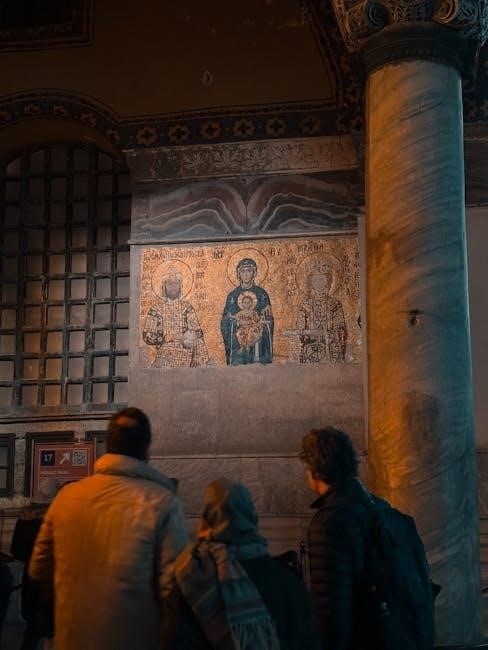The ‘I AM’ Statements of Jesus: An Overview
The Gospel of John uniquely presents Jesus using “I AM” statements, echoing Exodus 3:14, where God reveals Himself․ These declarations unveil Jesus’ divine identity and purpose․ Each statement offers a glimpse into His nature, revealing truths about His mission and relationship with humanity․
The “I AM” statements are a distinctive feature of Jesus’ teachings, particularly prominent in the Gospel of John․ These declarations offer profound insights into His identity and mission․ Each statement begins with the powerful phrase “I AM,” a direct connection to the divine self-revelation in the Old Testament, specifically Exodus 3:14, where God identifies Himself to Moses as “I AM WHO I AM․”
This connection is crucial for understanding the significance of Jesus’ claims․ By using this phrase, Jesus is not merely making metaphorical statements; He is asserting a direct link to the divine, claiming equality with God․ These statements are not simply about what Jesus does, but about who He is – His very essence and being․
The seven “I AM” statements found in John’s Gospel serve as windows into Jesus’ divine nature and His role in salvation․ They reveal Him as the source of life, light, sustenance, protection, resurrection, truth, and connection with God․ Through these declarations, Jesus invites us to understand and embrace His true identity as the Son of God․

The Significance of ‘I AM’ in the Old Testament
The phrase “I AM” holds immense weight, rooted in Exodus 3:14․ God reveals Himself to Moses as “I AM WHO I AM,” signifying self-existence and eternal presence․ This divine declaration establishes God’s unique identity and authority throughout the Old Testament․
Exodus 3:14 and Divine Revelation
Exodus 3:14 stands as a cornerstone of understanding the “I AM” statements․ When Moses asks God’s name, God declares, “I AM WHO I AM․” This isn’t merely a name; it’s a profound statement of being․ It signifies God’s self-existence, independence, and eternal nature․ He isn’t defined by anything outside Himself; He simply IS․
This revelation carries immense significance․ It distinguishes the God of Israel from all other deities, which were often tied to specific places, times, or functions․ “I AM” transcends such limitations, portraying a God who is always present, always active, and always in control․
The phrase also implies a promise of presence and faithfulness․ God isn’t just declaring His existence; He’s assuring Moses (and all future generations) of His unwavering support․ He will be with them, guiding and protecting them, because He is the eternal “I AM․” This understanding profoundly shapes how we interpret Jesus’ use of the same phrase․
The “I AM” title in Exodus isn’t just a label, but a powerful revelation of God’s character and commitment to His people, laying groundwork for Jesus’ self-identification․

The Seven ‘I AM’ Statements in the Gospel of John
John’s Gospel uniquely features seven distinct “I AM” statements made by Jesus․ These declarations reveal His divine nature and purpose․ They offer profound insights into His role as Savior, provider, and the very essence of life itself for believers․
‘I am the Bread of Life’ (John 6:35)
In John 6:35, Jesus declares, “I am the bread of life; whoever comes to me shall not hunger, and whoever believes in me shall never thirst․” This statement, delivered after the feeding of the five thousand, speaks to a deeper, spiritual hunger․ Jesus positions Himself not merely as a provider of physical sustenance but as the source of eternal satisfaction․ He contrasts earthly bread, which satisfies only temporarily, with Himself, the true bread from heaven that offers everlasting life․
This “bread of life” is not just about avoiding physical hunger; it’s about fulfilling the soul’s deepest longings․ Coming to Jesus and believing in Him is akin to consuming this bread, nourishing the spirit and quenching the soul’s thirst for meaning and purpose․ He invites all who are weary and hungry for something more to come to Him, promising complete and lasting fulfillment through faith and relationship․ The promise of never hungering or thirsting again highlights the completeness and sufficiency found in Christ;
‘I am the Light of the World’ (John 8:12)
In John 8:12, amidst a tense encounter with religious leaders, Jesus proclaims, “I am the light of the world․ Whoever follows me will never walk in darkness, but will have the light of life․” This declaration is a powerful metaphor, associating Jesus with illumination, guidance, and truth․ He offers Himself as the beacon that dispels the darkness of ignorance, sin, and despair․ To follow Jesus is to embrace His teachings and example, allowing His light to penetrate and transform one’s life․
The promise of never walking in darkness signifies a life free from confusion, moral ambiguity, and spiritual blindness․ Instead, followers of Jesus receive the “light of life,” an inner illumination that guides their path and grants them understanding․ This light is not merely intellectual; it is a transformative force that brings clarity, purpose, and hope․ By embracing Jesus as the light, individuals step out of the shadows and into a life filled with truth and direction, empowered to live according to God’s will․
‘I am the Gate’ (John 10:9)
In John 10:9, Jesus declares, “I am the gate; whoever enters through me will be saved․ They will come in and go out, and find pasture․” This imagery presents Jesus as the sole access point to salvation and a fulfilling life․ The gate symbolizes a secure and protected entrance, implying that only through Jesus can one find true refuge and spiritual nourishment․ Entering through the gate signifies accepting Jesus as the way to God, acknowledging His authority, and trusting in His saving power․
The promise of being “saved” encompasses both present and future realities – deliverance from sin’s bondage and eternal life with God․ The phrase “come in and go out” suggests freedom and security within God’s care, with believers experiencing continuous provision and guidance․ Finding “pasture” symbolizes spiritual nourishment, indicating that Jesus satisfies the deepest longings of the soul, providing sustenance and abundance for those who trust in Him as the gate․
‘I am the Good Shepherd’ (John 10:11, 14)
In John 10:11 and 10:14, Jesus proclaims, “I am the good shepherd․ The good shepherd lays down his life for the sheep․․․ I am the good shepherd; I know my sheep and my sheep know me․” This declaration highlights Jesus’ selfless love and intimate connection with His followers․ The imagery of a shepherd evokes care, protection, and guidance, portraying Jesus as the ultimate provider and protector of His flock․
Laying down His life for the sheep demonstrates the depth of Jesus’ sacrifice and His unwavering commitment to their well-being․ Unlike a hired hand who flees at the first sign of danger, the good shepherd willingly faces any threat to safeguard His sheep․ This signifies Jesus’ willingness to endure suffering and death to redeem humanity․ Furthermore, the mutual knowledge between the shepherd and the sheep emphasizes a personal and intimate relationship, where believers recognize Jesus’ voice and follow His lead, experiencing His love and care in a profound and life-transforming way․
‘I am the Resurrection and the Life’ (John 11:25)
In John 11:25, amidst grief over Lazarus’ death, Jesus declares, “I am the resurrection and the life․ The one who believes in me will live, even though they die; and whoever lives by believing in me will never die․” This powerful statement offers hope and assurance of eternal life to those who believe in Him․ Jesus positions Himself not merely as a bringer of resurrection but as the very source of it․
This “I AM” statement transcends physical resurrection; it encompasses spiritual and eternal life․ Believing in Jesus grants life beyond earthly existence, conquering death’s ultimate power․ This promise extends to both those who die physically and those who remain alive until His return․ The statement underscores the transformative power of faith in Jesus, offering believers the assurance of everlasting life and a restored relationship with God․ Through faith in Jesus, death is not an end but a transition to eternal life, a profound truth offering solace and hope․
‘I am the Way, the Truth, and the Life’ (John 14:6)
In John 14:6, Jesus proclaims, “I am the way, the truth, and the life․ No one comes to the Father except through me․” This declaration asserts Jesus as the exclusive path to God․ “The way” signifies the means of access and reconciliation with God, highlighting Jesus’ role as the mediator between humanity and the divine․ “The truth” implies that Jesus embodies genuine reality and understanding, contrasting with deception and falsehood․
“The life” denotes not only physical existence but also spiritual and eternal life found in union with God; Jesus’ statement underscores that true life, characterized by purpose, meaning, and fulfillment, is attained through Him․ He is not merely one way among many but the sole avenue to the Father․ This exclusivity emphasizes the uniqueness of Jesus’ role in salvation and the importance of placing faith in Him alone․ This statement serves as a cornerstone of Christian belief, affirming Jesus as the ultimate source of truth, life, and access to God․
‘I am the True Vine’ (John 15:1, 5)
In John 15:1 and 15:5, Jesus declares, “I am the true vine, and my Father is the gardener…I am the vine; you are the branches․ If you remain in me and I in you, you will bear much fruit; apart from me you can do nothing․” This metaphor illustrates the vital connection between Jesus and His followers․ As the true vine, Jesus provides the source of nourishment and life for believers, who are the branches․
The Father, as the gardener, cultivates and cares for the vine, ensuring its health and productivity․ Remaining in Jesus, abiding in His love and teachings, is essential for bearing fruit – displaying the qualities of Christ-like character and engaging in fruitful service․ Without this connection to the vine, the branches wither and become unproductive․ This imagery emphasizes the dependence of believers on Jesus for spiritual vitality and the importance of maintaining a close relationship with Him through faith, obedience, and prayer․ The “True Vine” statement underscores the necessity of union with Christ for a flourishing and purposeful Christian life․

The Theological Implications of the ‘I AM’ Statements
The “I AM” statements of Jesus in the Gospel of John carry profound theological weight, asserting His divine identity and unique relationship with God the Father․ By using the phrase “I AM,” a direct reference to God’s self-revelation in Exodus 3:14, Jesus equates Himself with the God of the Old Testament, claiming equality and oneness with the Father․ This claim challenges the Jewish understanding of God and establishes Jesus as more than just a prophet or teacher; These statements reveal Jesus as the eternal, self-existent God incarnate, the Messiah promised in the Hebrew Scriptures․
Furthermore, each “I AM” declaration unveils a different facet of Jesus’ character and mission․ He is the Bread of Life, satisfying spiritual hunger; the Light of the World, dispelling darkness; the Gate, providing access to salvation; the Good Shepherd, caring for His flock; the Resurrection and the Life, conquering death; the Way, the Truth, and the Life, leading to God; and the True Vine, sustaining spiritual growth․ These declarations reveal the nature and character of God in Jesus Christ․ They invite believers to enter into a relationship with Him․

The Importance of Prayer and Surrender to Jesus Christ
Recognizing Jesus’ divine identity through His “I AM” statements necessitates a response of prayer and surrender․ Prayer becomes a vital connection with the God who declared “I AM,” allowing believers to communicate with the source of life, light, truth, and salvation․ Through prayer, we acknowledge our dependence on Him and seek His guidance, strength, and provision․ Surrender involves yielding our will to His, trusting in His wisdom and plan for our lives․ It is an acknowledgement that He alone is the way, the truth and the life․ It is to acknowledge His authority․
The “I AM” statements invite us to a deeper relationship with Jesus, one marked by humility, trust, and obedience․ Prayer and surrender are not mere religious exercises but transformative acts that align our hearts with God’s purposes․ By surrendering to Jesus, we invite Him to be the Lord of our lives․ We allow Him to lead us in the ways of righteousness․ Prayer becomes our lifeline to the divine, enabling us to experience the fullness of His grace and love․
